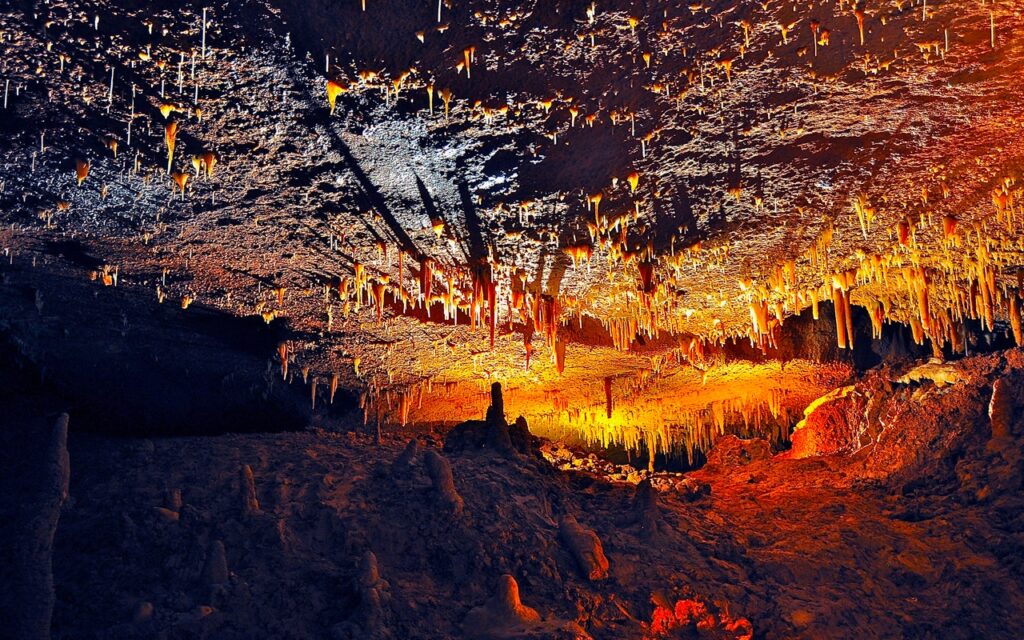In many theories about human origin, Africa is considered a place where humanity started its history. The scientists base their theories on rock art and artifacts of ancient humans’ lifestyle discovered there. The majority of these were found in South African caves.
The caves are also notable for their intricate tunnel passages, stalactite and rock formations, and unique relief. Some of the caverns are open to public tours, while others are only accessible to those who have received extreme caving training.
Whether you’re interested in anthropology and archaeology or simply want to visit a unique location, the South African caves will provide an unforgettable experience. A 20-hour flight from any of the airports in the USA will take you to an entirely different world.
Below is a list of 7 South African cavern sites that you should visit!
1. Sterkfontein Caves

These caves have become a site of anthropological research, as over 500 remnants of human-like species have been found there. Together with four other caverns, it forms the Cradle of Humankind—the complex of 30 limestone caves recognized as the monument of world heritage. According to various estimates, the human remains discovered in the caves date back about 2 million years. The discoveries in these caves have allowed the scientists to progress in their anthropological evolution theories and suggest the presence of Australopithecus in the evolution chain.
The complex is made up of six interconnected underground halls that reach a depth of about 130 feet. The caves are home to a variety of wild wasp species. Some scientists estimate that the fossils discovered in the caves are 3.5 million years old.
2. Cango Caves
The Cango Caves, a 2.5-mile-long network of grottos, are regarded as one of the most beautiful caverns in the world. According to various estimates, the limestone formations date back more than 150,000 years. The caves consist of three underground halls that are 60 feet tall. The largest hall is nearly 300 feet long and 160 feet wide. There are numerous gigantic stalagmites of diverse shapes. In some spots, the walls of the cave have a red tint due to the ferrous oxide presence.
The temperature inside the cave is around 65°F (18°C), and the humidity is high. There are numerous ascents and descents in the passage.
3. Sudwala Caves
These caves are the most ancient cavern complex currently known on Earth, dating back approximately 240 million years. The cavern system spreads for over 100 miles and consists of multiple passages and halls. Many of the cave objects have their own names. For example, stone formations are called “Samson’s Pillar”, “Screaming Monster”, “Lowveld Rocket”, and many others. The caves make a part of the dolomite ridge and feature numerous stalactites and stalagmites of various shapes and sizes.
The cave’s halls have their own names as well. The intricate relief of one of them is called “Wonderland.” On the ceiling of one of the halls, there’s rock art named “The Map of Africa.” Bats are the only animals that live in the caves. Other forms of life are extremely rare and are mostly represented by fossils.
4. Echo Caves
This cavern complex is quite old and is designated as a historic monument. The caves’ name “Echo Caves” refers to the long sound travel distance occasionally discovered by the local people. The sound can be heard over 25 miles. The underground complex consists of a system of passages and halls, one of which is about 200 feet tall. However, other parts of the caves can make you bend to proceed further.
The complex is also a place of archaeological and anthropological finds dating back over 10,000 years. Some of the findings are exhibited in the Museum of Man and Science.
5. Cathedral Cave
The cave got its name from its previous use as a worship hall. It was a place where the Basotho tribe could worship their gods. The cave is 800 feet long and 165 feet wide. It has a natural recess in the center, forming a kind of a rock pool.
The variety of living species of this cave make it stand out from other similar complexes. There are specific types of lichens having a stained-glass tint. The place is also known for its colony of northern bald ibis, a rare species of birds.
6. Wonder Cave
It is the third-largest cave in the South African Republic and is estimated to be 1.5 million years old. It is a large one-hall cave occupying 500,000 square feet of underground space and measuring 500 feet wide. The place is notable for its multiple dripstone formations, and there are 14 stalactites and stalagmites reaching heights of 50 feet. Many of them are still growing today.
The cavern is 200 feet deep and can be accessed by an elevator. The cave is inhabited by a colony of bats.
7. Makapansgat Caves
The system consists of several caves that are known for the archaeological finds. The pebble stones, each with a distinct color and shape, are considered to be of natural origin but connected with Australopithecus activities. The stones are reddish-brown jasper with recesses and depositions on them. The latter gives them the appearance of a crudely crafted human face. One anthropological theory suggests that Australopithecines collected pebbles because of their unique appearance and preserved them in a cave for aesthetic and other purposes. Other objects and fossils related to Australopithecus were also found in different parts of the cavern system.